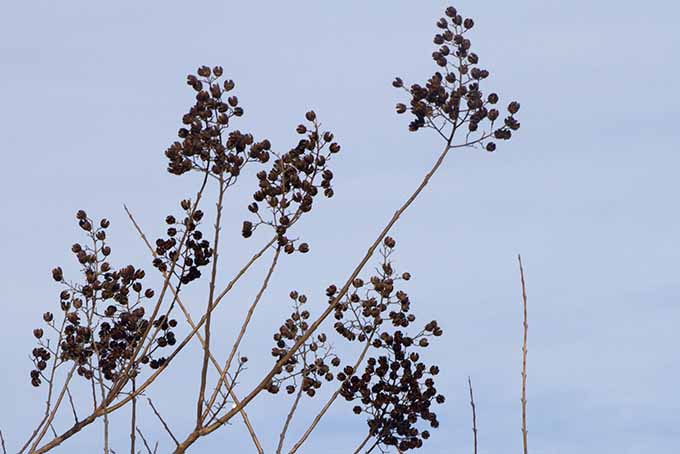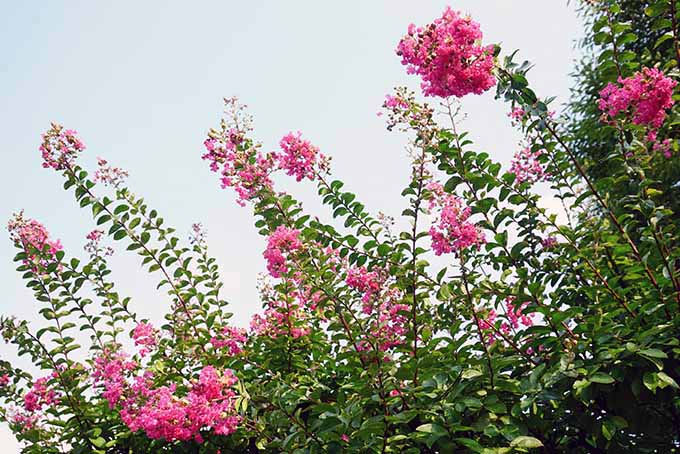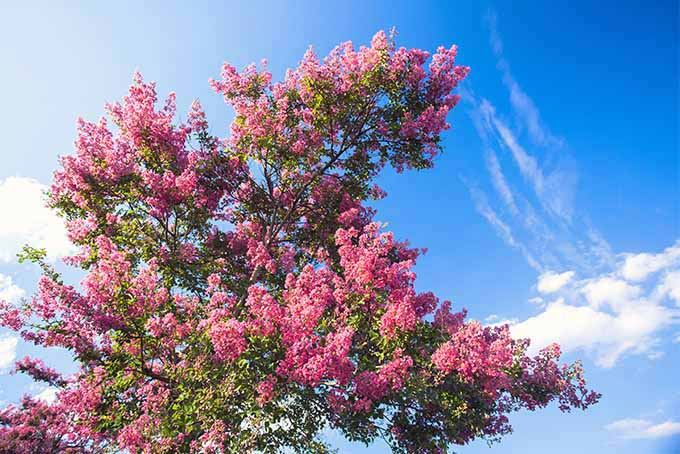Though not as ubiquitous as they are the Southeast, the crape myrtle’s range also extends to the Southwest and up the west coast, where they are also revered for their great beauty. Heralding summer’s arrival, crape myrtles erupt in May, June, or July with profuse clusters of delicate flowers in a myriad of colors, including white, various shades of pink, purple, yellow, and even red. As spectacular as they are in summer, in fall they lose their leaves and gardeners are left with bare branches, stems, and twigs begging to be whipped into shape. But how to trim? If you know anything about crape myrtles, you know this is a subject of great debate among home gardeners and experts alike. Let’s look at historical and modern best practices for pruning crape myrtle trees.
But First…
You might be shaking your head as you read this, admonishing us for our spelling. It is true that there are several accepted spellings for this alluring tree, including “crepe myrtle,” “crapemyrtle,” and the one we have chosen, “crape myrtle.” Authoritative sources far and wide differ on the correct way to spell the name of this plant species, all with good justification. Nevertheless, we chose “crape myrtle” because Merriam-Webster indicates it is their preferred spelling, and if you can’t trust the dictionary, what can you trust?
The Dark Ages
Once upon a time, these enchanting trees were “topped” — each trunk, limb and twig chopped to a uniform height across the width of the plant to create a plane so level you could balance a dinner plate on the butchered stalks. This type of “crape murder” results in stubby limbs from which long, gawky canes of new growth emerge. These skinny shoots are too weak to hold up their flowers, and they flop over like an overtired toddler in her highchair, or break off completely. Another result of overzealous annual pruning are the unattractive “knuckles” that form at the site of the cuts. These ugly, bulbous knots and bumps form over the years in response to repeated whackings. Add the knuckles to the gawky canes that flop, and your graceful tree becomes considerably less so. Furthermore, not allowing the trunks to mature means you’ll never get the attractive, mottled bark common to older trees. Sometimes this treachery was committed because “crape myrtles bloom on new growth,” as the wisdom went. And while they do bloom on new growth, they also bloom perfectly fine on old growth, thank you very much! Other times, a crape myrtle may be severely pruned to control the tree’s height. Nooooooo! If you need a smaller variety, dig up the one you have, move it, and replace it with one more appropriately sized, recommends North Carolina State University Cooperative Extension. Crapes are available in a wide range of sizes, from the shrub-like ‘Baton Rouge’ at two to three feet tall, to the towering ‘Natchez,’ which can grow to 30 feet. Additionally, severely pruning these colorful beauties can delay their bloom period by four to eight weeks. And, finally, remember that just because your neighbor does it doesn’t mean you have to.
So What’s the Right Way?
Whereas many plants do well with spring pruning, the best time to trim your crape myrtle is in late winter, before it leafs out. You can see the branches and twigs better before it’s all filled in. According to Clemson Cooperative Extension, if your tree is out of control with many trunks, for most crape myrtles you’ll want to choose three or five main trunks to preserve. As with many aspects of gardening, an odd number is more aesthetically pleasing than an even number. Keep straight, strong trucks that have plenty of room to grow. You’ll need these tools, and make sure they’re sharp and rust-free:
Hand pruners for twigs and branches less than 1/2-inch thick Loppers for branches 1/2 to 1 1/2-inches thick Pruning saw or pole pruner for branches thicker than 1 1/2 inches
When you’re ready to go, here’s the order in which you’ll judiciously shape your tree:
- Prune suckers and any trunks that need to go as close as possible to the main trunk or soil. This will avoid leaving insect-vulnerable and unsightly stubs.
- Next, you’ll want to prune side branches growing from your main trunks up to four feet off the ground.
- Then, look for higher branches that are growing inward toward the center of the tree, and get rid of those.
- Trim any branches that are crossing or rubbing against each other.
- Cut out any dead branches.
- Get rid of branches growing at odd angles and detracting from the tree’s appearance.
- You may choose to remove the seedheads at the end of the branches, or you may leave them. Leaving them does not reduce blooming. Now, you’ll have a beautifully shaped tree ready to burst into color.
Fixing Someone Else’s Mess
Let’s say you move into a new house and the previous owner so egregiously mauled a crape myrtle that you’re at an utter loss as to how to fix it.
Here’s how: Cut all the trunks completely to the ground, then carefully manage the shoots that come back. Save the vigorous and properly placed shoots, and cut the rest. The robust root system tied to the old tree will enable rapid growth, and you’ll have an attractive tree within a year or two.
Do You Even Need to Prune Them?
You certainly can get away without doing a speck of pruning on your crapes. They will leaf out and bloom beautifully and, to the untrained eye speeding by on the way to soccer practice, appear quite attractive. Over the millennia, more than one crape myrtle has gone un-pruned and has lived to tell the tale. But in your heart of hearts, you will know that the tree could look much cleaner, much shapelier, and simply better, with just a few quick cuts on a sunny February day.
Homework Assignment
If your trees are leafed out and in full bloom, pour a glass of iced tea, sit on the porch, and admire them. Think about how their shape might be improved. And then, come late winter, pull out your tools. With visions of delicate flowers dancing in your head, get to work creating even more spectacular trees. Are you guilty of butchery? Are you reformed? Tell us below! © Ask the Experts, LLC. ALL RIGHTS RESERVED. See our TOS for more details. Uncredited photos: Shutterstock.




